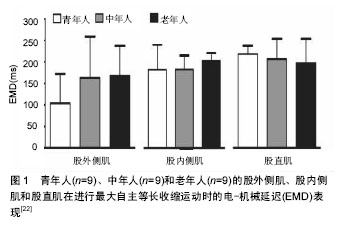| [1] Cavanagh PR, Komi PV. Electromechanical delay in human skeletal muscle under concentric and eccentric contractions. Eur J ApplPhysiolOccup Physiol. 1979;42(3):159-163.[2] Vos EJ,Harlaar J,van IngenSchenau GJ.Electromechanical delay during knee extensorcontractions. Med Sci Sports Exerc. 1991;23(10):1187-1193.[3] 陈建,周敬滨,解强,等.神经肌肉电刺激对前交叉韧带重建术后腘绳肌功能的影响[J].中国运动医学杂志. 2016; 35(8):750-753.[4] Flevas DA, Bernard M, Ristanis S, et al. Peroneal electromechanical delay and fatigue in patients with chronic ankle instability.Knee Surg Sports TraumatolArthrosc. Knee Surg Sports Traumatol Arthrosc. 2017;25(6):1903-1907.[5] Cè E,Rampichini S,Agnello L,et al.Effects of temperature and fatigue on the electromechanical delay components. Muscle Nerve. 2013;47(4):566-576.[6] Zhou S, Lawson DL, Morrison WE, et al. Electromechanical delay in isometric muscle contractions evoked by voluntary, reflex and electrical stimulation. Eur J Appl Physiol Occup Physio.1995;70(2):138-145.[7] Yavuz SU, Sendemir-Urkmez A, Türker KS. Effect of gender, age, fatigue and contraction level on electromechanical delay. ClinNeurophysiol. 2010;121(10):1700-1706.[8] Begovic H, Zhou GQ, Li T, et al. Detection of the electromechanical delay and its components during voluntary isometric contraction of the quadriceps femorismuscle.Front Physiol. 2014;5:494.[9] Nordez A, Gallot T, Catheline S, et al. Electromechanical delay revisited using very high frame rate ultrasound. J Appl Physiol. 2009;106(6):1970-1975.[10] Winter EM, Brookes FB.Electromechanical response times and muscle elasticity in men and women. Eur J Appl Physiol. 1991;63(2):124-128.[11] Szpala A, Rutkowska-Kucharska A, Stawiany M. Symmetry of electromechanical delay, peak torque and rate of force development in knee flexors and extensors in female and male subjects.ActaBioengBiomech. 2015;17(1):61-68.[12] Inglis JG, Vandenboom R, Gabriel DA.Sex-related differences in maximal rate of isometric torque development. J Electromyogr Kinesiol.2013;23(6):1289-1294.[13] Blackburn JT, Bell DR, Norcross MF, et al. Comparison of hamstring neuromechanical properties between healthy males and females and the influence of musculotendinous stiffness. J ElectromyogrKinesiol. 2009;19(5): 362-369.[14] Grosset JF, Piscione J, Lambertz D, et al. Paired changes in electromechanical delay and musculo-tendinous stiffness after endurance or plyometric training.Eur J Appl Physiol. 2009;105(1):131-139.[15] De Ste Croix MB, ElNagar YO, Iga J, et al. Electromechanical delay of the hamstrings during eccentric muscle actions in males and females: Implications for non-contact ACL injuries. J ElectromyogrKinesiol. 2015;25(6):901-906.[16] Conchola EC, Thiele RM, Palmer TB, et al. Effects of neuromuscular fatigue on the electromechanical delay of the leg extensors and flexors in young men and women. Muscle Nerve. 2015;52(5):844-851.[17] Karamanidis K, Arampatzis A. Mechanical and morphological properties of human quadriceps femoris and triceps surae muscle-tendon unit in relation to aging and running. J Biomech. 2006;39(3):406-417.[18] Reeves ND. Adaptation of the tendon to mechanical usage. J Musculoskelet Neuronal Interact. 2006;6(2):174-180.[19] Chung SG, Van Rey EM, Bai Z, et al. Aging-related neuromuscular changes characterized by tendon reflex system properties. Arch Phys Med Rehabil. 2005;86(2):318-327.[20] Grosset JF, Mora I, Lambertz D, et al. Age-related changes in twitch properties of plantar flexor muscles in prepubertalchildren. Pediatr Res. 2005;58(5):966-970.[21] De Ste Croix MB, Priestley AM, Lloyd RS, et al. ACL injury risk in elite female youth soccer: Changes in neuromuscular control of the knee following soccer-specific fatigue. Scand J Med Sci Sports. 2015;25(5): 531-538.[22] Libardi CA, Souza TM, Conceição MS, et al. Electromechanical delay of the knee extensor muscles: comparison among young, middle-age and older individuals. ClinPhysiolFunct Imaging. 2015;35(4):245-249.[23] Smith CM, Housh TJ, Hill EC, et al. Changes in Electromechanical Delay During Fatiguing Dynamic Muscle Actions. Muscle Nerve. Muscle Nerve. 2016 Dec 9.[24] Zhou S,McKenna MJ,Lawson DL,et al.Effects of fatigue and sprint training on electromechanical delay of knee extensor muscles.Eur J ApplPhysiolOccup Physiol. 1996;72(5-6): 410-416.[25] Rampichini S, Cè E, Limonta E, et al. Effects of fatigue on the electromechanical delay components in gastrocnemius medialis muscle. Eur J Appl Physiol. 2014;114(3):639-651.[26] Cè E, Rampichini S, Monti E, et al. Changes in the electromechanical delay components during a fatiguing stimulation in human skeletal muscle: an EMG, MMG and force combined approach. Eur J Appl Physiol. 2017;117(1):95-107.[27] Smith CM, Housh TJ, Hill EC, et al. Dynamic versus isometric electromechanical delay in non-fatigued and fatigued muscle: A combined electromyographic, mechanomyographic, and force approach. J ElectromyogrKinesiol. 2017;33:34-38.[28] Downey RJ, Merad M, Gonzalez EJ, et al. The Time-Varying Nature of Electromechanical Delay and Muscle Control Effectiveness in Response to Stimulation-Induced Fatigue. IEEE Trans Neural Syst Rehabil Eng. 2016 Nov 8. [Epub ahead of print].[29] Edwards JN, Cully TR, Shannon TR, et al. Longitudinal and transversal propagation of excitation along the tubular system of rat fast-twitch muscle fibres studied by high speed confocal microscopy. J Physiol. 2012;590(3):475-492.[30] Fitts RH. The cross-bridge cycle and skeletal muscle fatigue. J Appl Physiol. 2008;104(2):551-558.[31] Debold EP.Recent insights into the molecular basis of muscular fatigue. Med Sci Sports Exerc. 2012;44(8):1440-1452.[32] Zhang LQ, Rymer WZ. Reflex and intrinsic changes induced by fatigue of human elbow extensor muscles. J Neurophysiol. 2001;86(3):1086-1094.[33] 马力宏. 反应时、电-机械延迟之研究[J]. 天津体育学院学报. 1988;7(4):26-29.[34] Hannah R, Minshull C, Smith SL, et al. Longer Electromechanical Delay Impairs Hamstrings Explosive Force versus Quadriceps. Med Sci Sports Exerc. 2014;46(5):963-972.[35] Chen HY, Chien CC, Wu SK, et al. Electromechanical Delay of the VastusMedialisObliquus and VastusLateralis in Individuals With Patellofemoral Pain Syndrome. J Orthop Sports PhysTher. 2012;42(9):791-796.[36] 王国祥,张秋霞,鲍捷. 髌腱末端病运动员膝关节动作反应的变化特征[J].中国康复医学杂志,2011;26(9):838-842.[37] Linford CW, Hopkins JT, Schulthies SS, et al. Effects of neuromuscular training on the reaction time and electromechanical delay of the peroneus longus muscle.Arch Phys Med Rehabil. 2006;87(3):395-401.[38] Begovic H, Zhou GQ, Schuster S, et al. The neuromotor effects of transverse friction massage. Man Ther. 2016;26:70-76.[39] Ristanis S, Tsepis E, Giotis D, et al. Electromechanical delay of the knee flexor muscles is impaired after harvesting hamstring tendons for anterior cruciate ligament reconstruction. Am J Sports Med. 2009;37(11):2179-2186.[40] Freddolini M, Battaglioli A, Chiechi F, et al. Electromechanical delay of the knee flexor muscles after anterior cruciate ligament reconstruction using semitendinosus tendon. Sports Biomech. 2015;14(4):384-393.[41] Stock MS, Olinghouse KD, Mota JA, et al. Muscle group specific changes in the electromechanical delay following short-term resistance training.J Sci Med Sport. 2016;19(9):761-765.[42] Costa PB, Herda TJ, Walter AA, et al. Effects of short-term resistance training and subsequent detraining on the electromechanical delay. Muscle Nerve. 2013;48(1):135-136.[43] Szpala A, Rutkowska-Kucharska A, Drapala JElectromechanical delay of abdominal muscles is modified by low back pain prevention exercise.ActaBioengBiomech. 2014;16(3): 95–102.[44] Ristanis S,Tsepis E,Giotis D, et al. Knee flexor muscle responses under fatigue after harvesting the hamstrings for anterior cruciate ligament reconstruction. Clin J Sport Med. 2011;21(4):288-293. |
.jpg)


.jpg)